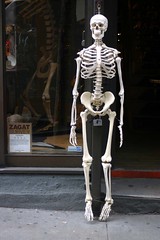 Future of NYC: How bad will it get?
Future of NYC: How bad will it get?
To determine the impact of the current recession, it is instructive to look back at past economic downturns.
By:Greg David, Originally posted on Crain's, January 06, 2009 3:00 PMPhotograph: "Herman, once a tri-athelete, patiently awaits ANY public transportation in NYC this weekend..." A. Golden, eyewash design - c. 2006.
Editor’s note: This is the first in a series of stories on New York City’s economy, which is the focus of the upcoming Crain’s conference, The Future of New York City. Join the discussion here.
Understanding how bad the current economic crisis will be in New York requires a history lesson.
In the past four decades, New York has been engulfed by three major recessions:
-225,000 jobs were lost in the economic downturn the city suffered after the Sept. 11 terrorist attacks.
-325,000 jobs were cut in the late 1980s and early 1990s.
-610,000 jobs disappeared in the disastrous 1970s.
The official forecasts—from the Bloomberg administration and city and state comptrollers—claim the current crisis will be less severe than any of the others. But comparing Wall Street today with manufacturing in the 1970s shows that is a debatable proposition.
Eight years ago, the national economy weakened before New York faltered. By the spring of 2001, Wall Street began retrenching, eventually shedding 35,000 jobs in the city. The terrorist attacks led to significant disruption but little permanent economic damage. A determined effort to bolster the tourism industry in the aftermath of Sept. 11 did much to lay the groundwork for a recovery. The boroughs outside Manhattan and the suburbs were little affected. The difficulties spanned four years; the rebound that began in 2004 was unexpectedly strong.
In the late 1980s, the nation also slipped into recession before New York. The city’s economy was undermined by a contraction on Wall Street brought about by the end of the 1980s bull market. The decline was deepened by three other major forces. A speculative real estate boom driven by tax breaks—not demand—led to overbuilding that took years to absorb. An expansion of government-financed jobs—on the city payroll as well as at social service and health care nonprofits—raised taxes so high that thousands of economically sensitive companies left, including Exxon and J.C. Penney. The crime wave fueled by crack cocaine led to 2,000 murders in one year and resulted in civic fear that delayed a recovery for years. The pain was felt in the entire region as Westchester, Long Island and the nearby counties of New Jersey all lost 9% of their employment base.
Hard times lasted seven years, and the recovery was anemic at first.
The disaster of the 1970s is remembered most for the fiscal crisis, the result of a misguided mission to turn the city into a welfare state. The government ran out of money because the effort coincided with the rapid erosion of the city’s manufacturing base—287,000 jobs were lost during the decade from what was then the city’s economic engine—while flight to the suburbs and beyond led to an unprecedented population decline of almost 900,000. Recovery, which took a decade, is remembered as very difficult, although the city’s comeback was able to continue despite two recessions in the rest of the country.
This time, there won’t be the population exodus of the 1970s. The unprecedented federal efforts to rescue the economy could help, too. Yet, one comparison may be more telling. The city seems certain to lose 50,000, or about 40%, of its Wall Street jobs. That’s a larger share than the roughly one-third of industrial jobs lost in the 1970s.
Live your values. Love your country.
And, remember: TOGETHER, We can make a DIFFERENCE!





















No comments:
Post a Comment